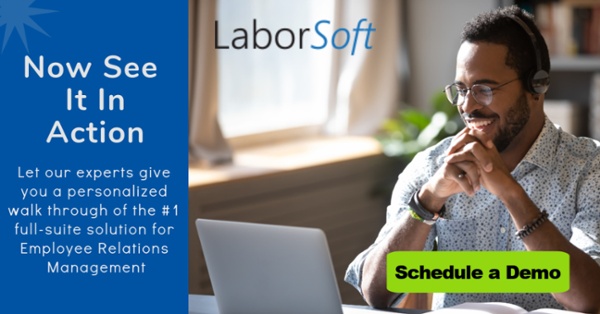Labor Relations | Employee Relations
How Employers Can Mitigate Risks During a Labor Dispute
Read Time 4 mins | Mar 21, 2024 | Written by: Frankie Kourtis

Is your organization entering or already in the midst of an HR event or labor relations issue? Resolving disputes and grievances is urgent, but can also be a complex and delicate matter that requires great care. If you’re looking for a way to keep track of current labor disputes and move them along efficiently while mitigating your risks, the following tips are a great place to start.
What Is a Labor Dispute?
Cornell Law School uses the following labor dispute definition:
The term “labor dispute” includes any controversy concerning terms, tenure or conditions of employment, or concerning the association or representation of persons in negotiating, fixing, maintaining, changing, or seeking to arrange terms or conditions of employment, regardless of whether the disputants stand in the proximate relation of employer and employee.
In essence, this means a labor dispute is a disagreement between an employer and employees regarding things such as:
- Conditions of employment
- Conditions in the workplace
- Benefits packages
- Work hours or schedule requirements
- Terms negotiated during collective bargaining
Disputes regarding these terms or conditions can involve both employee relations and labor relations specialists, depending on whether the dispute is between the employee and the employer or a union or other outside agency (as with the National Labor Relations Board).
The resolution of labor dispute cases requires a combination of swift action and abundant caution. To make experience possible while maintaining accuracy and thoroughness, follow the four best practices below.
Four Ways to Mitigate Risks in Labor Dispute Cases
1. Review Current Legal & Compliance Requirements
One of the biggest risks to a successful labor case resolution — even if it’s unintentional — is non-compliance with labor laws, reporting requirements, collective bargaining agreements, arbitration procedures, or other legal responsibilities. Pay careful attention to current legal requirements so you can act with compliance throughout the process.
If your labor dispute involves unionized employees, any lapses can quickly escalate a dispute from an employee relations issue to a labor relations issue, further complicating the resolution process (especially for companies that are not located in right-to-work states).
Take time to review not only the details and terms of your internal handbooks and policies but also any potentially relevant labor laws or labor union rules and regulations before you engage in discussions and attempt resolution.
2. Centralize All Communication and Documentation
A labor dispute can involve many types of communications and documents, from photos and video footage to written testimony about the issue, notes or transcriptions from employee interviews, and more.
Any inaccuracies or disorganization in your documentation can weigh down or disrupt the rest of the case management process. Antiquated document management solutions, such as spreadsheets, are a huge risk.
You’ll want a comprehensive case management platform that keeps all communications and documentation in one place in a central repository of data, so nothing is missed. This repository should make it easy to store, search, and archive all case-related information while helping your HR department track procedural steps and simplify reporting. The right platform will help you manage labor disputes without all the headaches.
3. Pay Close Attention to Procedural Deadlines
It is the responsibility of employee and labor relations managers to stay on time with all steps of the labor dispute process and ensure that all deadlines are met. By closely observing time limits on each step (as outlined in company policies, the CBA, or relevant labor laws), you can demonstrate good faith and respect for the complainant, facilitating a smoother resolution.
Automated deadline reminders and digital reporting forms with auto-fill capabilities can assist with timeliness. Explore your options for a purpose-built labor case management software system that provides these and other features to ensure procedures progress efficiently.
4. Navigate Potential Courses of Action With Predictive Analytics
Predictive analytics can help your HR team feel more confident that they’re taking the right course of action in the labor dispute process. After all, this grievance is not a singular event. Insights drawn from historical patterns of related or similar disputes can help case managers avoid short-term thinking and identify root causes as well as resolution strategies that are more likely to work in situations like this.
Data on employee retention, employee turnover, grievances, outcomes, and other labor metrics can all play a role. Software tools with analytics capabilities, like LaborSoft, can help you by analyzing data from prior cases and providing insights into successful case resolution patterns as well as potential sources of breakdowns in the process.
Schedule a Customized LaborSoft Demonstration
Our software helps employers keep all employee and labor relations cases organized with a unified document repository, automation, and analytics. Get in touch to set up a demonstration today and settle your labor disputes more efficiently — or prevent them from occurring in the first place.


